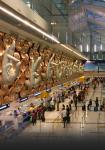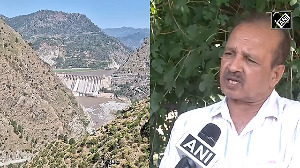The next time someone asks you who the architect of a project is, you might do better to point them in the direction of the engineers or, to put it technically, the MEP (mechanical, electrical, plumbing) service providers.
Typically, these unsung and largely anonymous backroom boys account for as much as 45-55 per cent of a building cost and bear the burden of reducing energy waste over the life cycle of the structure. And yet, for all the Hafeez Contractors and Charles Correas, you might be hard put to remember the named of any MEP service provider.
It's something Prem C Jain, chairman and managing director of Spectral Services Consultants, could pass over with a wink and a grin. When he started out in 1980, after a decade with the Stein, Doshi and Bhalla powerhouse in the capital, he knew he would meet a difficult challenge in trying to convince architects of his services.
Fortunately for him, just then the Asian Games in New Delhi were around the corner and he landed the contracts for providing the back room services for several of the hotels coming up then -- whether it was the Samrat, Le Meridien or the Centaur. (Spectral has since worked on over 100 hotels all over the country.)
"Total optimisation," says Jain, "is a nightmare for architects." That's where Spectral helped -- Jain, after all, had spent 15 years in the United States and was able to bring is several best practice norms into the industry.
"An architect has vision," Jain points out, "but a building will not work without us." This involves interaction with the architect from an early stage -- now mandatory, but probably more difficult three decades ago -- for invaluable inputs on everything from best elevator placements in a building to sewage disposal and transformer restrictions. "We quantify an architect's wish," he qualifies.
The architect was easy to leverage, but Jain's current challenge -- and he says it is his largest one -- comes from interior designers. "To convince them to save energy is impossible, they make you pay a very heavy price," he rues. Yet, it is this need to conserve not capital cost (hence bottomlines, which developers want for short-term profits) but long-term cost optimisation that promoters or owners seek that has been part of Spectral's long journey.
So, while he's willing to comply with vaastu requirements (especially big in the south), Jain says they argue with architects on everything from window placements to the need for a water softening plant for airconditioners to increase their efficiency. "Energy," he explains, "boils down to the HLP or heat, light, power consumed in a building."
Typically, till the 1980s, 20 per cent of any building's revenue went into feeding energy requirements. Subsequent architects fought to bring it down so that by the time the Oberoi group was building its luxe Vilas properties, the HLP cost was down to 12-13 per cent. When Jain promised to bring it down further to 10 per cent, he bagged the contract -- and then went on, he says, to lower the HLP percentage to just 7 per cent through the selection and orientation of windows, roof and wall insulations, double glazing, and perhaps lots of common sense.
That's because by now Jain was fully drawn into and a proponent of green buildings (he founded the Indian Society of Heating, Refrigerating and Airconditioning Engineers, based on its parent American model). He was already rooting for international technologies to be brought to India, and when Bill Clinton voted that the US Green Building Council set up shop in India, he pulled out all stops and, with CII ("it jumped at the idea"), launched the Indian Green Building Council.
Everything just came together when, on what now seems a whim, a handful of people decided to produce, in Hyderabad, not just a green building but the world's greenest building. Spectral came in with architect Karan Grover on the project, the Godrej Business Centre which, when completed in 2003, lived up to its ambitious hype. It harnesses light, repels heat, and has set the green building movement pretty much rolling in India.
While architects like Grover and Vidhur Bhardwaj have long been committed to the cause -- "a green building is largely driven by an architect" and its basis is not just the energy it conserves but also the least energy consumed in making the materials with which it has been built -- increasingly even conscientious developers in Mumbai, Pune and the south are committing themselves to green buildings.
"Traditional India has always been green," explains Jain. For now, he says, Pune is way ahead of other cities where green buildings are concerned, while in southern India even municipalities are thinking of green homes.
Today's technologies have found solutions and that make energy saving easier while keeping costs low. "My office in India" -- it seats 160 -- "uses no artificial light at all," says Jain.
For now, a green building costs 2.5-3 per cent more than a conventional building, but as a billion sq ft of buildings under construction in India over the next five years go green, Jain is convinced that "a green building could cost less than a conventional building". Thereby putting a stop to all arguments.








 © 2025
© 2025